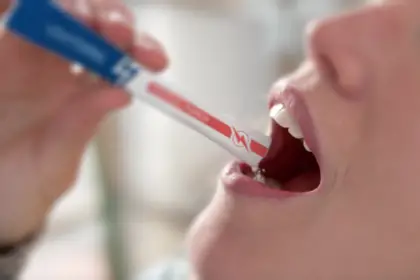In the modern era, where the interplay of technology and convenience shapes the very essence of our homes, the significance of lighting extends far beyond its functional purpose. The warm radiance of incandescent bulbs and the cool efficiency of LED lights define the ambiance of our living spaces, often without a second thought.
However, a recent groundbreaking study has cast a shadow over this familiar landscape, revealing an unsettling truth: some of the very lights that illuminate our homes could be casting long-term repercussions on our eyes and disrupting our precious sleep quality.
As we venture into the depths of this study’s revelations, a disconcerting reality comes into focus: the lights we trust to brighten our lives may inadvertently be dimming our eye health and the restorative nature of our sleep. Join us as we embark on a journey to decipher the implications of these findings and to comprehend how the common lighting choices we make might have far-reaching consequences that extend well beyond the switch.
It’s time to reevaluate our relationship with illumination, as we explore the intricate connections between light, vision, and the tranquility of sleep, and ultimately strive for a clearer, more soothing future for our eyes and our nights.
In the ever-evolving landscape of modern lighting, LED lights have carved their way to the forefront, touted for their remarkable energy efficiency and extended lifespan. However, as our world becomes increasingly illuminated by these efficient sources of light, a disconcerting revelation has emerged – certain types of LED lights, particularly those emitting blue light, might be jeopardizing not only our eye health but also the quality of our sleep.
Studies On Blue LED Lights
A comprehensive study conducted by the esteemed French Agency for Food, Environmental and Occupational Health & Safety (ANSES) has brought these concerns to the fore. The agency’s meticulous research has uncovered an alarming truth: blue LED lights, widely used in various lighting applications, could potentially inflict severe and lasting damage on our eyes.
ANSES’s findings paint a vivid picture of the dangers posed by blue LED lights. The retina, the delicate tissue at the back of our eyes responsible for converting light into neural signals, appears to be particularly vulnerable to the intense wavelengths and high brightness emitted by these lights.
The potential risks extend to all those who find themselves under the glare of blue LED lights, but ANSES’s research identifies specific groups that are at a heightened risk. Children, individuals who are routinely exposed to LED lighting due to their occupational demands, and those grappling with pre-existing eye conditions stand at the crossroads of greater susceptibility.
Alarming as it may be, ANSES’s study is far from an isolated revelation. Numerous experiments conducted on laboratory animals, particularly rats, have echoed the same concerns. Blue LED lights have been linked to an array of ocular afflictions, ranging from retinal damage to the impairment of photoreceptors – the cells responsible for capturing and transmitting light signals to the brain.
Most disconcertingly, blue LED lights have been implicated in the onset of macular degeneration, a debilitating condition that progressively erodes central vision.
Understanding the science underlying the issue is key to comprehending the gravity of the situation. At the core of the concern lies the concept of frequency and color in the world of light.
The Science Of LED Lights
LED, or “light-emitting diode,” bulbs produce light by emitting photons as electrons traverse a semiconductor within the bulb. These photons are what we perceive as light, and their frequency determines their color. The lower frequencies manifest as warmer, redder tones, while the higher frequencies yield cooler, bluer hues. White LED lights, commonly used in households and workplaces, are essentially a blend of red and blue frequencies.
However, the distinction lies in the nature of blue light’s frequency. Positioned higher on the visible spectrum, blue light possesses a greater potential to penetrate ocular structures, potentially causing profound damage. This intrinsic property renders blue LED lights a subject of concern for eye health advocates and researchers alike.
Yet, it’s important to note that the message isn’t one of complete abstinence from LED lighting. Instead, the crux of the matter lies in being selective about the color spectrum. By favoring warmer tones of light that emulate the hues of natural sunlight, individuals can significantly reduce their exposure to the potentially harmful effects of blue LED lights.
Harnessing the Healing Power of Light: Red and Near Infrared Light Therapy
Amidst growing concerns about the potential hazards of certain types of lighting, a promising ray of hope emerges from an unexpected source – red and near infrared light therapy. Unlike their blue counterparts, these wavelengths of light have been garnering attention for their potential to promote healing, alleviate discomfort, and enhance overall well-being.
Research into red and near infrared light therapy, often referred to as photobiomodulation or low-level light therapy, has unveiled a range of potential benefits. These wavelengths have shown the ability to penetrate deeper layers of tissue, influencing cellular processes in ways that could offer profound advantages.
From promoting tissue repair and reducing inflammation to boosting collagen production and supporting cellular energy production, the therapeutic potential of red and near infrared light is a compelling avenue worth exploring.
One such innovative device that brings the benefits of red and near infrared light therapy to your fingertips is the Mito Mobile Flex. This handheld device offers a convenient and versatile approach to harnessing the power of light for healing.
With its targeted application and portability, the Mito Mobile Flex opens doors to incorporating light therapy into your daily routine, potentially offering relief from discomfort, improved skin health, and a heightened sense of vitality.
Click Here To Learn More About Mito Mobile Flex
In a world dominated by screens, blue LED lighting poses an additional threat. The screens of LED televisions, computer monitors, smartphones, and tablets often employ this type of lighting, subjecting users to prolonged exposure. Consequently, limiting screen time, especially during the evening hours, emerges as an essential step toward preserving eye health and fostering better sleep quality.
As we navigate the intricate relationships between light, vision, and sleep, ANSES’s study serves as a sobering reminder that our choices about illumination resonate far beyond mere aesthetics. In the pursuit of a well-lit and harmonious environment, it is imperative that we prioritize our ocular well-being and sleep quality, for in doing so, we shed light on a path toward a healthier, more enlightened future.









